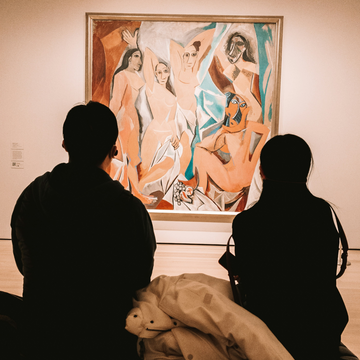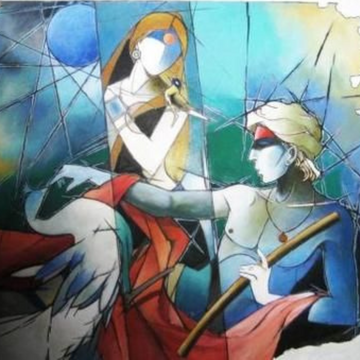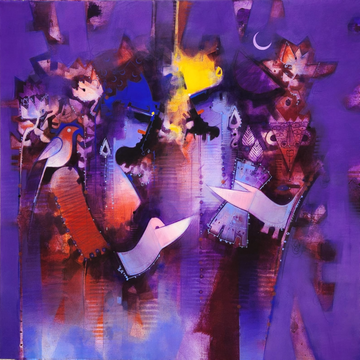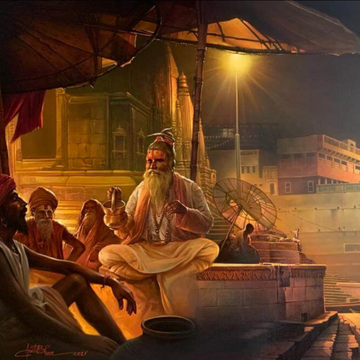Prolific. Prodigious. Promiscuous. The life and works of Pablo Picasso

Author-Ria Sarkar, For Eikowa
“Art washes away from the soul the dust of everyday life.” ~Pablo Picasso
Pablo Picasso is hailed as one of the most celebrated artists of the twentieth century not just because he enjoyed a long and successful career, but also mainly because during his lifetime he coursed through multiple mediums, materials and styles leaving behind a multi-billion dollar legacy for his offspring and their successive generations. His unparalleled mastery of forms and figures, his pioneering contributions to the Cubist movement and his ability to develop novel ideas time and time again led to the creation of a body of work that is considered to be priceless.

Unlike many great artists who could not reach their full potential due to untimely deaths, Picasso died at a ripe old age of 91, enjoying and taking advantage of every opportunity at achieving success. Over a span of six to seven decades as a prolific artist, Picasso made 1,885 paintings, 1,228 sculptures, 7,089 drawings, 30,000 prints, 3,222 ceramic works along with numerous illustrated books, copperplates, theater sets, costumes and tapestries that add up to more than 45,000 works in total. His immense contribution to the field of art is a constant in the collective consciousness of the contemporary art world, and his famous works are still circulated and exhibited across the globe every year. If he were alive today, he would have been one of the richest men in the world.
An artist is born: Early life
The shaping of modern and contemporary art in Europe was deeply influenced by Picasso’s experiments and contributions to various art movements - starting from Realism, Abstraction, Primitivism, Neoclassicism, Cubism, Surrealism and Expressionism. The legendary artist created a diverse range of works that raised many pertinent socio-political and intellectual concerns, notwithstanding taking part in political propaganda during the Spanish Civil War in WWII.
He was born in a city called Malaga, Spain, in 1881, which is located in the Andalusian region. From a very young age he showed great proficiency in the arts, growing up under the tutelage of his father Don José Ruiz, who was a painter and an art teacher. His father specialized in naturalistic depictions of birds and other game, but upon discovering his son’s unique talent he stopped painting hoping that his son would become an academic painter one day.
Picasso received formal training in the arts briefly in Madrid in 1897, then in Barcelona in 1899. During his time in Barcelona he became closely associated with the local intellectuals that gathered at The Four Cats (Els Quatre Gats) who were a diverse mix of modernist poets, writers, and artists, including the Catalan Carlos Casagemas who became one of Picasso’s closest friends.
At the age of 15 he created his first major painting which was an academic work titled “First Communion”, featuring a portrait of his father, mother, and younger sister kneeling before an altar.

Casagemas and the dreary Blue period
At the turn of the century Picasso and Casagemas relocated to Paris, which was the central hub for modernist artists at the time, and set up a studio in Montmartre. Commonly regarded as the underbelly of Parisian life, Montmartre exposed Picasso to prostitutes, harlequins and the like, influencing much of his subject matter in the years to come. During his stay he frequented many art galleries as well as the bohemian cafés, night-clubs, and dance halls of Montmartre, drinking in the unabashed liberality and hedonism that was widespread in 19th-20th century Paris. Picasso also bagged his first “job” when the famous art dealer Pedro Manach offered him 150 francs per month in exchange for pictures. His first Paris painting was “Le Moulin de la Galette”, now part of the permanent collection in Guggenheim Museum, New York. After just two months, Picasso went back to Barcelona, stopped in Málaga, and finally arrived in Madrid where he became co-editor of the magazine Arte Joven. From then on he lived intermittently between Paris and Spain for many years.
In the meantime, Casagemas was nursing a broken heart from a failed love affair. Despite Picasso’s attempts to amuse him, Casagemas went over the edge. In February 1901, he tried to shoot the woman he loved, eventually turning the gun on himself and committed suicide at a café in Paris. The impact of his death on Picasso was profound and would emerge in his dreary depictions of the Blue Period. It has been named so due to Picasso’s predominant use of murky blues and the overwhelming feelings of darkness, despair and loneliness in his paintings, while the artist grappled with the loss of his best friend. “I began to paint in blue, when I realized that Casagemas had died” Picasso later wrote.

Apart from creating many works featuring Casagemas, a lot of derelict figures populated Picasso’s canvases during this period. It seems that while he was depressed and impoverished, he was drawn to the poverty-stricken, underprivileged section of society. One of his key works is ‘The Blind Man’s Meal’ made in 1903, where Picasso paints a poor blind man holding a crust of bread in one hand and awkwardly grasping for a pitcher with the other. The painting is shrouded in a dull blue that brings out the gloominess of the man’s condition as well as the artist’s current state of mind.

Picasso’s stormy love affairs
“Love is the greatest refreshment in life” ~ Pablo Picasso
Picasso was well known for his promiscuity and passionate affairs throughout his life. He married twice and was unfaithful each time, unable to resist going after the “new and the untried”. Out of the many lovers and girlfriends, Picasso had six great muses in his entire life, of which three bore his children- one legitimate and three illegitimate.
His first serious relationship was with Fernande Olivier in Paris (1904), an artist model who stayed as his mistress for seven years. Before the end of their relationship Picasso had moved on to Eva Gouel by 1912, only to be devastated on account of her early death due to tuberculosis or cancer. Grieved by her loss he painted many pictures to remember her by, yet it did not curtail his interest in other women.
In 1917 Picasso met the ballerina Olga Khokhlova, who became Picasso’s first wife. They had a troubled relationship as Olga’s formal high society background clashed with Picasso’s grounded middle-class lifestyle. They had a son named Paolo (Paul) in 1921, who went on to have three children - Pablito, Marina and Bernard.

Perhaps one of Picasso’s most famous muses was Marie-Therese Walter, a 17-year-old girl that Picasso fell in love with while he was still with Olga (in 1927). She was the inspiration behind his famous work ‘Le Reve’ and possibly the ‘Vollard Suite’ etchings. They had an illegitimate child together, since he was still married to Olga when the child Maya was conceived. Marie’s unquestioned devotion to the artist was true till the end and she hanged herself four years after Picasso’s death.

While he was with Marie, Picasso became interested in Dora Maar, a Surrealist photographer who documented his most famous work – Guernica, and stayed with him till 1944 until the arrival of Francoise Gilot. Gilot was a 21-year-old law student who abandoned her studies for an affair with Picasso. They had an age gap of 40 years and had two children- Claude and Paloma. Frustrated with his blatant promiscuity and abusive nature, Gilot eventually left him. In 1953, Picasso met Jacqueline Roque, and decided to take to matrimony again. She became his second wife and stayed with him until his death. She was Picasso’s longest relationship, lasting a good twenty years, and also his strongest muse inspiring more than 400 works from an ageing Picasso.

Other movements and styles
Picasso’s work is divided into many periods – the early period in Spain (1897-1900), the Blue Period (1901–1904), the Rose Period (1905–1907), the African-influenced Period (1908–1909), Analytic Cubism (1909–1912), and Synthetic Cubism (1912–1919), Classical and Surrealist period (1918-1936), WWII and Spanish Civil War (1936-1945) and towards his final years came the Late Works (1946-1973).
After the depressing canvases of the Blue Period, Picasso’s Rose Period (1904–1906) comprises of a range of bright colors in a ‘rose’ tone (yellow ochre, gray, pink and orange) featuring interesting figures from the circus like clowns and harlequins. Picasso developed an affinity for circuses and visited the Circus Medrano in Montmartre along with Fernande Olivier, who was Picasso’s mistress for seven years (from 1904 to 1912).

The next stage marked the beginning of Cubism with the famous ‘Le Demoiselles d’Avignon’, which was described by critics as being inspired by African influences. Picasso visited an ethnographic museum and was intrigued by the African artifacts and sculptures that he saw there. True to his nature, he was itching to try something new and attempted to combine his theories on cubism with the angular structures associated with a primitivist approach. The critics were quick to dismiss this stage as an imitation of African ethnic art, but Picasso refused these claims by explaining, “In the Demoiselles d’Avignon I painted a profile nose into a frontal view of a face. I had to depict it sideways so that I could give it a name, so that I could call it ‘nose’. And so they started talking about Negro art. Have you ever seen a single African sculpture - just one - where a face mask has a profile nose in it?”

Braque and Cubism
Les Demoiselles caught the attention of artist Georges Braque, who was part of the Fauvist movement at the time. Picasso joined hands with Braque in the summer of 1908 to become co-originators of the most radical movement of 20th century art – Cubism. They conducted experiments with forms and figures on their numerous trips to the countryside, only returning to find that they had come up with very similar pictures totally independent of each other. Braque's compositions incorporated the Cubist aim of representing the world as seen from a number of different viewpoints. He wanted to create mobility in his paintings by playing around with space, or rather creating an illusion of space.
For Picasso, Cubism was an initiative partly inspired by his longstanding preoccupation with Cezanne’s flattened depiction of space, some borrowed principles of geometric abstraction and the need to express three dimensionality on a two dimensional plane. The name of the movement was actually given by a critic Louis Vauxcelles who upon seeing the landscapes Braque had painted in 1908 at L’Estaque in emulation of Cézanne, called the geometric forms in the highly abstracted works as “cubes.”

The movement was divided into two phases – the first was Analytic cubism (1909–1912), where Picasso and his followers analyzed shapes and forms turning to monochrome and neutral colors. In this sub-sect Cubists broke down form and space so that objects and pictorial space could intersect in a fragmented fashion against each other, sometimes overlapping, which actually highlights the two-dimensionality of the canvas. The second was Synthetic Cubism (1912–1919), where the focus was on the texture of the shapes and figures created in a collage-like fashion with cut paper fragments. Synthetic Cubists discarded the “analysis” of objects and instead focused on “constructing” or “synthesizing” objects through the overlapping of larger, more discrete forms that seemed as if they might have been cut and pasted to the canvas. This new form of Cubism was popular during the 1930s, featuring a variety of patterns, vivid colors, undulating lines and different kinds of shapes.

Guernica: Picasso’s politically charged artwork
Guernica is Picasso’s greatest masterpiece, which is his depiction of the bombing of a Spanish town by German forces, during the Spanish civil War in WWII. The Spanish government had requested Picasso to paint a mural for the Spanish pavilion at the Paris World Exhibition. Initially he planned to depict the subject “a painter in his studio”, but when he heard about the events in Guernica, he changed his original plans and instead gave his own personal account of the tragedy. His gigantic mural Guernica is a fitting reminder of the atrocities committed in Guernica with contorted figures, decapitated heads of horses and many other symbols all squished into one frame representing the aftermath of an attack. Though painted for the Spanish government, Picasso had decreed that it should not become Spanish property until the end of fascism. When asked to explain this famous piece, Picasso said, “It isn’t up to the painter to define the symbols. Otherwise it would be better if he wrote them out in so many words! The public who look at the picture must interpret the symbols as they understand them.”

Posthumous value of paintings: Rights and Sales
During the second half of his life, Picasso became quite rich and lived lavishly in a villa located in the South of France. But his children and grandchildren are now fighting a nail-biting battle for possession of rights to Picasso’s massive collection of works. In 1996, Claude Picasso who was anointed as the legal administrator of Picasso’s estate created the Picasso Administration. Based in Paris, this organization was solely dedicated to manage the heirs’ jointly owned interests, control the rights to Picasso reproductions and exhibitions, issue merchandising licenses, pursue forgeries, stolen works, and illegal use of Picasso’s name.
Several paintings by Picasso rank among the most expensive paintings in the world. ‘Garçon à la pipe’ sold for US$104 million at Sotheby's on 4 May 2004, ‘Dora Maar au Chat’ sold for US$95.2 million at Sotheby's on 3 May 2006. Recently, on 4 May 2010, ‘Nude, Green Leaves and Bust’ was sold at Christie's for a whopping $106.5 million, a painting showing Marie-Thérèse Walter reclining and as a bust.
Last year on 11 May 2015 his painting ‘Women of Algiers’ set the record for the highest price ever paid for a painting when it sold for US$179.3 million at Christie's in New York. Since 2004, Picasso is ranked as one of the most coveted artists based on the sales of his works. With more than 190 museums all over the world housing his works, the artist’s legacy is truly unforgettable.














